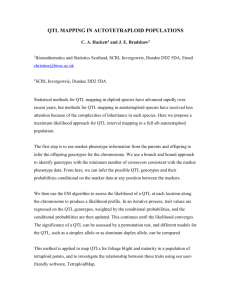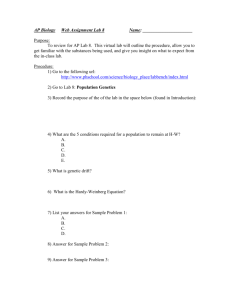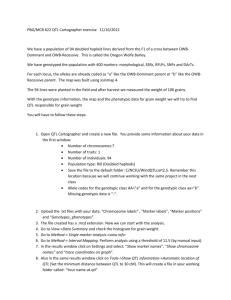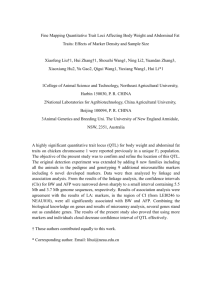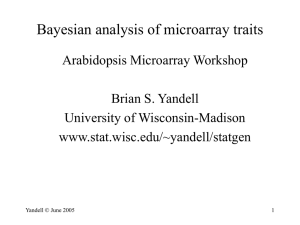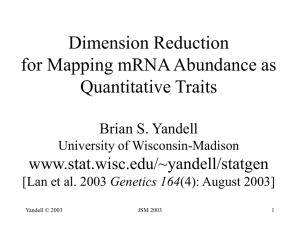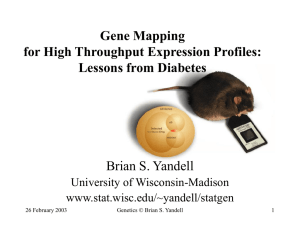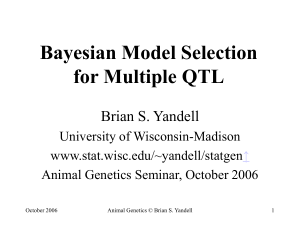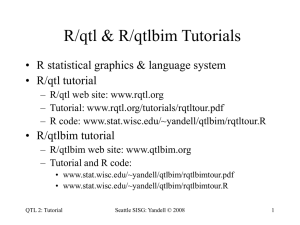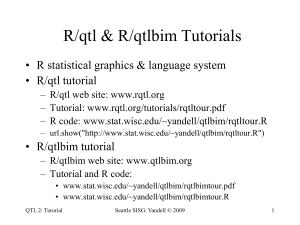2007.stat998
advertisement
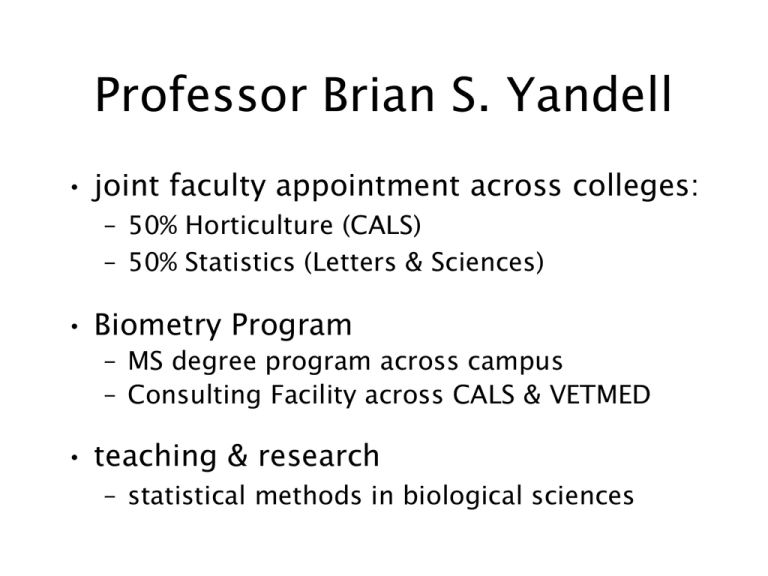
Professor Brian S. Yandell • joint faculty appointment across colleges: – 50% Horticulture (CALS) – 50% Statistics (Letters & Sciences) • Biometry Program – MS degree program across campus – Consulting Facility across CALS & VETMED • teaching & research – statistical methods in biological sciences who am I (professionally)? • Professor Brian S. Yandell • joint appointment across colleges: – 50% Horticulture (CALS) – 50% Statistics (Letters & Sciences) – UW-Madison since 1982 • Biometry Program • teaching & research Biometry Program • MS Degree – – – – – co-advise with biologist bridge biology & stats project & oral report consulting experience 10 completed, 1 current • Genetics • Botany, Dairy Sci (2), Hort, Land Resources, Meat & Animal Sci, Wildlife Ecology (2), Zoology • Consulting Facility – statistical consulting • 5 faculty, 2-3 students – computing assistance • 2 staff + operators – self-help model • guide research ideas • build skill sets – collaboration • students faculty staff • CALS & VETMED & L+S Research & Teaching • statistical genetics – QTLs in Brassica • time to flowering – QTLs in mouse model • diabetes model – multiple generations – micro-arrays – 2 current students • statistical ecology – population ethology – individual-based simulations • stats consulting – communication skills – write, plot, talk – bridge stats & biology • linear models – experimental design – complicated analysis – problems directly from consulting – published textbook what is statistics? We may at once admit that any inference from the particular to the general must be attended with some degree of uncertainty, but this is not the same as to admit that such inference cannot be absolutely rigorous, for the nature and degree of the uncertainty may itself be capable of rigorous expression. — Sir Ronald A. Fisher (1935 The Design of Experiments) digital.library.adelaide.edu.au/coll/special/fisher what is statistics? • There are three types of lies--lies, damn lies and statistics. – Benjamin Disraeli or Alfred Marshall or Mark Twain? (attributed) • Statistics is the science of science. (Bill Hunter) • Statistics is the science of learning from experience. (Brad Efron, inventor of the bootstrap) what is biology? Biology … consists of two rather different fields, mechanistic (functional) biology and historical [evolutionary] biology. Functional biology deals with … cellular processes, including those of the genome. … [Evolutionary biology] involve[s] the dimension of historical time. — Ernst Mayr at 100 (What Makes Biology Unique? 2004 Cambridge U Press) what is bioinformatics? • emerging field interrelated with statistical genetics, computational biology and systems biology • goal: use computational methods to solve biological problems, usually on the molecular level – applied mathematics, informatics, statistics, computer science, artificial intelligence, chemistry and biochemistry • research on sequence alignment, gene finding, gene mapping, genome assembly, protein structure, gene expression and protein-protein interactions, modeling evolution http://en.wikipedia.org/wiki/Bioinformatics Genome data analysis: how did I get involved? • how do plants modify flowering time? – intense collaboration • QTL gene mapping • Bayesian interval mapping methodology – subsequent to my involvement • fine mapping of FLC analogs in Brassica • sequencing of TO1000 genome • how do mice (humans) develop diabetes? – genetic association • QTL model selection • fine mapping: SORCS1 in mice & humans – biochemical pathways: • feature selection • causal models Yandell “Lab” Projects • Bayesian QTL Model Selection – R software development (Whipple Neely) – collaboration with UAB & Jackson Labs – data analysis of SCD1, ins10 • meta-analysis for fine mapping Sorcs1 – Chr 19 QTL introgressed as congenic lines – combined analysis across to increase power • QTL-based causal biochemical networks – algorithm development (Elias Chaibub) – data analysis with Jessica Byers The intercross (from K Broman) QTL mapping: idea • phenotype y depends on genotype q – – – – pr(y | q, µ) q may be multivariate (multiple QTL) linear model in q (or semiparametric) possible interactions among QTL (epistasis) • missing data: many genotypes q unknown – pr(q | m, ) – measure markers m linked to q (correlated) – form of genotype model well known QTL mapping: picture LOD = log10(LR) BC with 1 QTL: IM vs. BIM LOD and LPD: QTL at 100 2.0 12 substitution effect 2nd QTL? 2nd QTL? 2 1.0 0.5 substitution effect 6 1 5 -0.5 lod 8 50 1000 0.0 10 4 blue=ideal 1.5 black=BIM purple=IM 0 0 50 100 Map position (cM) 150 200 0 50 100 Map position (cM) 150 200 glucose (courtesy AD Attie) insulin studying diabetes in an F2 • mouse model: segregating panel from inbred lines – B6.ob x BTBR.ob F1 F2 – selected mice with ob/ob alleles at leptin gene (Chr 6) – sacrificed at 14 weeks, tissues preserved • physiological study (Stoehr et al. 2000 Diabetes) – mapped body weight, insulin, glucose at various ages • gene expression studies – RT-PCR for a few mRNA on 108 F2 mice liver tissues • (Lan et al. 2003 Diabetes; Lan et al. 2003 Genetics) – Affymetrix microarrays on 60 F2 mice liver tissues • U47 A & B chips, RMA normalization • design: selective phenotyping (Jin et al. 2004 Genetics) “final” analysis for logins10 Df Model 10 Error 405 Total 415 Sum Sq Mean Sq F value Pr(>F) 14.054 14.054 122.16 < 2.2e-16 *** 46.591 0.115 60.645 14.169 Single term deletions Df Sum of Sq <none> sex 1 5.82 Chr2@84 1 1.37 Chr5@36 1 1.47 Chr8@30 1 0.04 Chr16@36 1 0.95 Chr17@54 1 0.10 Chr19@43 1 0.09 RSS 46.59 52.41 47.97 48.06 46.63 47.54 46.69 46.69 Chr8@30:Chr19@43 Chr17@54:Chr19@43 1 1 1.18 0.58 47.78 10.2969 0.0014386 ** 47.17 5.0366 0.0253561 * sex:Chr19@43 1 0.36 46.96 F value Pr(F) 50.6234 11.9512 12.8085 0.3583 8.2330 0.8591 0.8200 5.115e-12 0.0006039 0.0003869 0.5497918 0.0043290 0.3545425 0.3657200 *** *** *** ** 3.1675 0.0758684 . logins10: main effects for Chr 2,5,16 (only additive part significant) p=0.0004 p=0.0008 p=0.004 2.0 Interaction plot for D19Mit58 and D17Mit180 D19Mit58 D19Mit58 1.8 AA AB BB 1.8 1.6 AA AB BB 1.6 logins10 logins10 logins10: interactions with Chr 19 Interaction plot for D19Mit58 and D8Mit289 1.4 1.4 1.2 1.0 1.2 0.8 1.0 AA AB D8Mit289 BB AA AB D17Mit180 BB QTL Meta-analysis in mice yields human diabetes target Susanne Clee, Brian Yandell, …, Mark Gray-Keller, …, Jerome Rotter, Alan Attie 1 November 2005 log10(ins10) Chr 19 black=all blue=male red=female purple=sexadjusted solid=512 mice dashed=311 mice Sorcs1 study in mice: 11 sub-congenic strains marker regression meta-analysis within-strain permutations Nature Genetics 2006 Sorcs1 gene & SNPs Sorcs1 study in humans Diabetes 2007 central dogma via microarrays (Bochner 2003) genetical genomics: mapping microarrays (Jansen Nap 2001) 2M observations 30,000 traits 60 mice QTL mapping thousands of gene expression traits PLoS Genetics 2006 Causal vs Reactive? (Elias Chaibub, Brian Yandell) y1 causes y2: y1 ~ g1 and y2 ~ g2*y1 7 phenotype 6 edge causal model how does correct edge orient vary over graph? lipid metabolism network

